
Woljeong-ri station is a closed railway station on the Gyeongwon Line in South Korea. It was closed by the Korean War. It is a noted place in the Korean Demilitarized Zone. [1]

Woljeong-ri station is a closed railway station on the Gyeongwon Line in South Korea. It was closed by the Korean War. It is a noted place in the Korean Demilitarized Zone. [1]
Woljeong-ri station is a historical building in the DMZ at Cheorwon. [2] This tourist attraction, which can only be visited on escorted security tours of the DMZ, is an abandoned train station on the northernmost end of Korail's Gyeongwon Line. [3]
Near the station was a small yard where rail stock was stored or shunted before leaving for Wonsan, now in North Korea, along the former Gyeongwon Line. Behind the station building, there remains the wreck of a train bombed during the Korean War. [3] The train was used by the North Korean army, and was bombed by U.N. forces. "The windows of the train car are twisted toward the sky and the frame and the body of the train are crooked and rusty." [4]


In 2012, as part of the history of its time, it had become a place where artists meet and exhibit their works. At the closed railway station, works by Noh Suntag, British artist Simon Morley, and a video installation artist by Kim Sylbee were on display. "Kim created the video installation Friendly Fire, which presents a science-fiction story of fratricidal tragedy, paralleling the situation on the Korean Peninsula." "It's parallel from our current situation but also my own projection of the future from reading history,” said Kim. “I called this project Friendly Fire; you're shooting not your enemy but your friend. There's kind of a more tender feeling in [the name]." [1]
In 2014, artists again visited the northernmost region of South Korea, for an art presentation, with the railroad division of the Gyeongwon Line building's abandoned space utilized as part of the project. Artist Choi Jae's blue neon light shining on the floor inside the building, reading, "No borders exist in nature", was an artistic work which was part of the exhibit. [5]

Gangwon State, is a Special Self-Governing Province of South Korea. It is known as the largest and least densely populated subdivision of South Korea. Gangwon is one of the three provinces in South Korea with special self-governing status, the others being Jeju Province and Jeonbuk State. Gangwon is bordered on the east by the East Sea, it borders Gyeonggi Province to the west, North Gyeongsang Province and North Chungcheong Province to the south, and the Military Demarcation Line to the north, separating it from North Korea. In the 1945 division of Korea, the historical Gangwon Province was divided in half, and remains so to this day. The northern portion is administered by the DPRK and is called Kangwŏn Province

The Korea Railroad Corporation (Korean: 한국철도공사; Hanja: 韓國鐵道公社, branded as KORAIL, is the national railway operator in South Korea. Currently, KORAIL is a public corporation, managed by Ministry of Land, Infrastructure and Transportation.
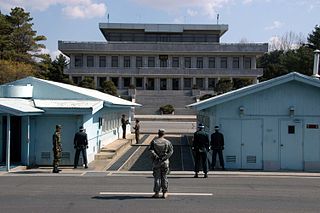
The Korean Demilitarized Zone is a heavily militarized strip of land running across the Korean Peninsula near the 38th parallel north. The demilitarized zone (DMZ) is a border barrier that divides the peninsula roughly in half. It was established to serve as a buffer zone between the countries of North Korea and South Korea under the provisions of the Korean Armistice Agreement in 1953, an agreement between North Korea, China, and the United Nations Command.
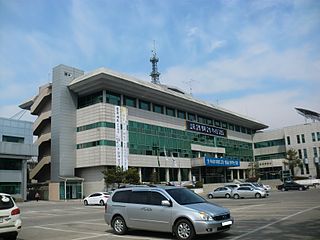
Cheorwon County, also spelled Chorwon, is a county in Gangwon Province, South Korea. It is located right next to the border with North Korea.

The Military Demarcation Line (MDL), sometimes referred to as the Armistice Line, is the land border or demarcation line between North Korea and South Korea. On either side of the line is the Korean Demilitarized Zone (DMZ). The MDL and DMZ were established by the Korean Armistice Agreement.
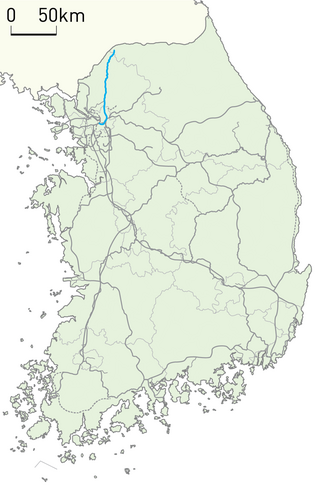
The Gyeongwon Line is a railway line serving northeastern Gyeonggi Province in South Korea. The line is operated by Korail. The name of the line came from Gyeongseong (Seoul) and Wonsan, the original terminus of the line, in what is now North Korea.

Paju is a city in Gyeonggi Province, South Korea. Paju was made a city in 1997; it had previously been a county (gun).

The Donghae Bukbu Line is a former railway line that connected the present-day city of Anbyon in Kangwon Province, North Korea, with Yangyang, Gangwon Province, South Korea. Since the division of Korea it has only carried trains for a brief period during 2007/8. The line originally connected to the Gyeongwon Line running from Gyeongseong to Wonsan.
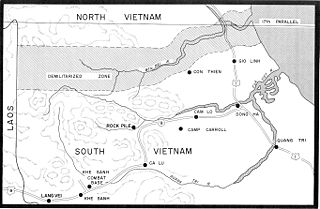
The Vietnamese Demilitarized Zone was a demilitarized zone at the 17th parallel in Quang Tri province that was established as the dividing line between the two countries i.e. North Vietnam and South Vietnam from 22 July 1954 to 2 July 1976 when Vietnam was officially divided into the two military gathering areas, which was intended to be sustained in the short term after the First Indochina War.

Kijŏng-dong, Kijŏngdong, or Kijŏng tong is reportedly a Potemkin village in P'yŏnghwa-ri, Panmun-guyok, Kaesong Special City, North Korea. It is situated in the North's half of the Korean Demilitarized Zone (DMZ). Also known in North Korea as Peace Village, it has been widely referred to as 'Propaganda Village' by those outside North Korea, especially in South Korean and Western media.
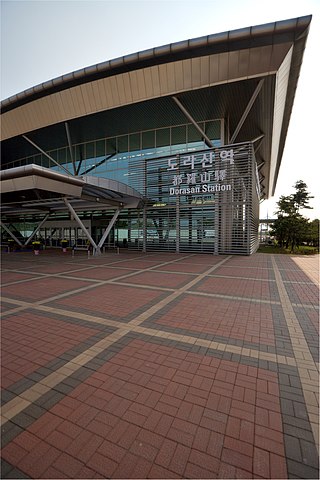
Dorasan Station (Korean: 도라산역) is a railway station situated on the Gyeongui–Jungang Line, which formerly connected North Korean and South Korean rail systems and has since been restored. Dorasan station is located approximately 650 meters from the southern boundary of the Korean Demilitarized Zone and is currently the northern terminus of Korail's Gyeongui-Jungang Line, which is served by Shuttle Service to Imjingang Station. North of here the former Gyeongui Line continues as the Korean State Railway's P'yŏngbu Line, but this connection is not in regular service. The current purpose of the station is largely symbolic of the hope for eventual Korean reunification.

The Battle of White Horse Hill took place during the Korean War. White Horse Hill in the Iron Triangle, formed by Pyonggang at its peak and Gimhwa-eup and Cheorwon-eup at its base, a strategic transportation route in the central region of the Korean peninsula.

Baengmagoji station is a railway station on the Gyeongwon Line in South Korea. The station opened on 20 November 2012. This station is named after Baengmagoji, the site where the Battle of White Horse took place in 1952, during the Korean War.

The Kangwŏn Line is a 145.8 km (90.6 mi) electrified standard-gauge trunk line of the Korean State Railway of North Korea, connecting Kowŏn on the P'yŏngra Line to P'yŏnggang, providing an east–west connection between the P'yŏngra and Ch'ŏngnyŏn Ich'ŏn lines.

DMZ Train is a South Korean excursion train operated by Korail. The train began operations in 2014 and transports tourists from Seoul to train terminals closest to the Korean Demilitarized Zone. The service was suspended in 2019 and has not yet resumed operation. Due to the aging issue of the trains, the DMZ Train ended its operation on 28 December 2023.
The Gyeongwon Line was a railway line of the Chosen Government Railway in central Korea. It was the first east–west trunk line to be opened, connecting the capital Gyeongseong to the important east coast port of Wonsan. Following the partition of Korea, the line was divided between North and South Korea.
The September 2018 inter-Korean summit was the third and final inter-Korean summit in the 2018-19 Korean peace process.

DMZ Peace Train Music Festival is a music festival held in Cheorwon County, Gangwon Province, South Korea. It is held close to the border with North Korea, and is intended to promote peace and unification at a place symbolizing division of the Korean Peninsula. It was held as relations between the two Koreas warmed up.

Search is a South Korean television series starring Jang Dong-yoon, Krystal Jung, Moon Jeong-hee, Yoon Park and Lee Hyun-wook. It follows the story of the ruthless attack of an unknown creature in the Korean Demilitarized Zone, and the search operation of elite special force to uncover the truth. It aired on OCN from October 17 to November 15, 2020, every Saturday and Sunday at 22:30 (KST). The series is available for streaming with multi-languages subtitles on iQIYI in South East Asia, Hong Kong, Macau and Taiwan.